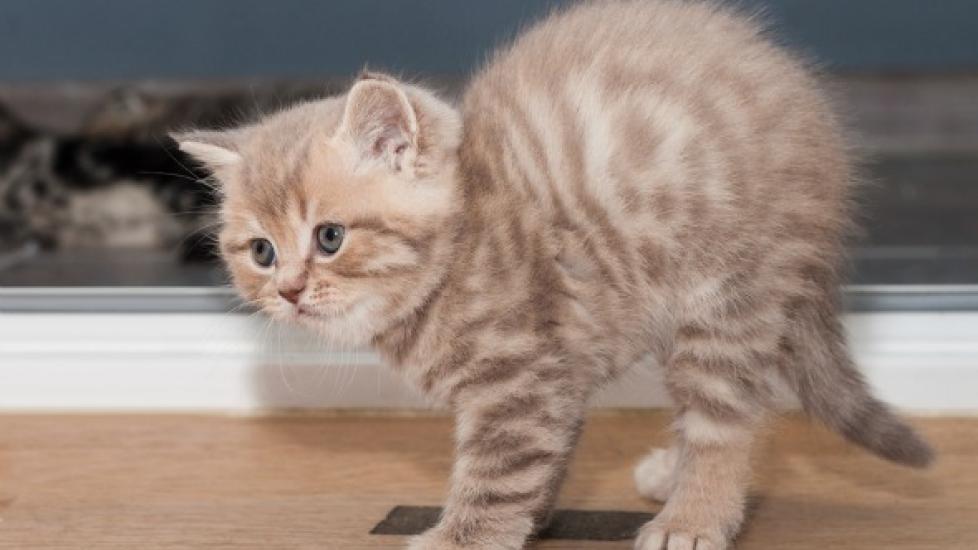Spinal and Vertebral Birth Defects in Cats
Congenital Spinal and Vertebral Malformations in Cats
Congenital spinal and vertebral malformations are most often genetically inherited (as opposed to adverse conditions during fetal development). Specifically, sacrococcygeal dysgenesis (defective development) is a dominant trait, while thoracic hemivertebra (chest half-vertebra) is a recessive trait.
Spinal malformations are usually evident at birth or in the first few weeks of life. On the other hand, vertebral malformations can be latent until the cat undergoes a growth spurt, sometimes not becoming apparent for several months. Visible signs of a distorted spinal column are lordosis (curvature of the spine at the lower back) and kyphosis (a posterior curvature of the spine).
Scoliosis (a lateral curvature of the spine) is also an easily visible form of vertebral malformation. If the malformations lead to secondary spinal cord compression and trauma, the affected cat will display ataxia and paresis. Medicine often does not resolve neurological manifestations of spinal and vertebral malformations. If the condition is severe and untreatable, euthanasia should be considered.
Symptoms and Types
- Malformation of the occipital bones – atlas and axis (the first and second cervical vertebrae at the base of the skull):
- Causes compression of the upper spinal cord, which can lead to paralysis, sudden death
- Hemivertebra (half a vertebra)
- Kyphosis, scoliosis, lordosis
- Wedge shaped vertebrae, causes angle in the spine
- Most likely to affect the neurological system
- Rear limb weakness (paraparesis), paralysis
- Transitional vertebra
- Has characteristics of two types of vertebrae
- May result in cord compression, disc changes
- Block vertebra
- Fused vertebrae due to improper segmentation of vertebrae
- Cat may live normally without symptoms
- Butterfly vertebra
- Vertebra with a cleft through the body and a funnel shape at the ends (giving appearance of butterfly on X-ray examination)
- Causes instability of the vertebral canal, and rarely, compression of the spinal cord with paralysis
- May remain without symptoms
- Spina bifida
- Lack of vertebral arches in the spinal column
- Accompanies sacrococcygeal dysgenesis – a defective formation of the lowest vertebrae in the spine, resulting in a stumped tail
- Variable spinal dysplasia (abnormal development); dysraphism (defective spinal fusion); syringomyelia (cyst in the spinal cord); hydromyelia (enlarged central canal in the spinal cord where excess cerebrospinal fluid builds up); and myelodysplasia (defective development of the bone marrow)
- Weakness in rear limbs (paraparesis), hopping gait
- Inherited as an autosomal dominant trait in the Manx breed
- Myelodysplasia
- Defective development of the bone marrow
- Congenital spinal stenosis (narrowing of the spinal canal - malformation from birth, hereditary)
Causes
- Genetic inheritance
- Possibly, exposure of pregnant queens to:
- Compounds causing birth defects during fetal development
- Toxins
- Nutritional deficiencies
- Stress
Diagnosis
You will need to give your veterinarian a thorough history of your cat's health and onset of symptoms. A full physical exam will be performed. X-rays of the spinal column (including all vertebrae) can often reveal the exact malformation. If neurological signs (paralysis) are present, a myelography can be used to indicate with precision at which level the spinal cord is compressed. This imaging technique uses a radiopaque substance that is injected into the spine, or into the membranous space that surrounds the spinal cord so that the defects in the spine will be visible on X-ray projections.
Computed tomography (CT) and magnetic resonance imaging (MRI) may also be helpful, and are in some cases much more sensitive than X-rays. However, myelography is generally the diagnostic imaging technique of choice.
Treatment
Surgery can be helpful for cases involving narrowing of the spinal canal and decompression of the spinal cord. Secondary damage due to spinal compression may be avoided if surgical intervention takes place early on. If the spinal compression is diffuse or long-term, your cat may not respond to surgery. If your cat has an opening in the skin where the spinal malformation is present, it may be surgically repaired.
If your cat is showing neurological signs such as dizziness, seizures or paralysis postoperatively, restricted activity combined with physical therapy may be helpful.
Living and Management
Your cat will need to revisit your veterinarian every four to six months for neurological examinations and to monitor progression of clinical signs. X-rays will be retaken with each follow-up visit as well.
In some cases, management of long term symptoms will be necessary. Fecal and urinary incontinence are common, as well as constipation and urinary tract infections. Medications to soften the feces, an easily digestible diet, and occasional treatment with antibiotics is standard for some cats with spinal malformations.
Cats that have been diagnosed with this defect should not be bred, nor should their parents be bred further, since congenital spinal and vertebral malformations are hereditary. Spaying and neutering is strongly recommended for these animals.
